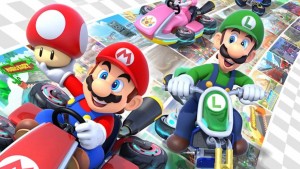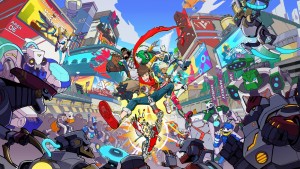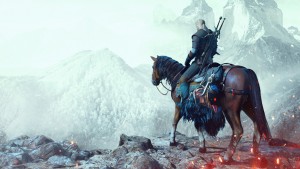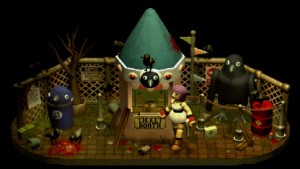Please support Game Informer. Print magazine subscriptions are less than $2 per issue
MachineGames Talks Wolfenstein Trilogy, Bloody Road Trips, And Doom
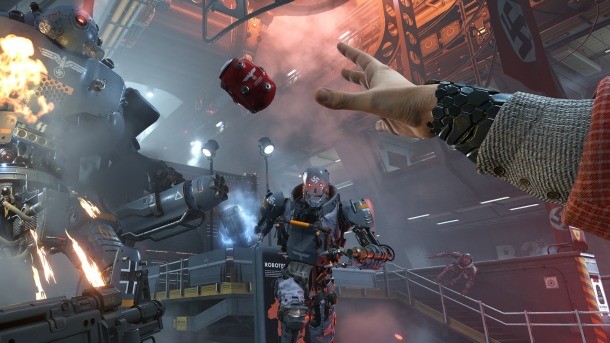
In 2009, much of Starbreeze Studios, the developer behind critical darlings The Chronicles of Riddick: Butcher Bay and The Darkness, left to found MachineGames. In 2014, MachineGames released Wolfenstein: The New Order to praise for the game's blend of strong storytelling and old-time First-person shooter action. During a preview event for Wolfenstein II: The New Colossus, we got a chance to chat with creative director Jens Matthies for this thoughts on the developer's vision of Wolfenstein, the relationship between MachineGames and id Software, and what we can expect from Wolfenstein II. (Note: This interview has been edited)
We’re going to a lot of places in The New Colossus: New Orleans, Roswell, Manhattan. Would you call The New Colossus a roadtrip game, like The Last Of Us but with Nazis instead of zombies?
[Laughs] That’s a good analogy, actually! It’s funny because we knew early on when we were making The New Order that we wanted to make a trilogy, so we had our sort of grand scheme of things of how events would progress in a sequel. We always thought for a sequel that it would be amazing to go to the U.S. not just because it’s a cool setting but also because it’s BJ’s homeland. So there’s this experience of him going to a place where he grew up and just see it taken over by his mortal enemies, that’s a powerful thing conceptually.
We knew where we were going and then we just solicited ideas from the team. Everyone on the team just pitched on what would be the coolest places to turn into levels, knowing we’re doing a sort of U.S.-centric geography. And we had tons of really cool ideas. So on one hand you want to do stuff that isn’t over-exploited but on the other, you want some really nice U.S. icons to see how do those turn out under the Nazi oppression. So I think it’s a healthy mix of those.
Both Fergus and Wyatt show up in the trailers we’ve seen and the content we’ve played for Wolfenstein II. Does this mean that the game supports both timelines from The New Order?
Yes, you’ll be able to choose your timeline in the game’s prologue. We support both timelines.
The New Colossus, both conceptually and level-wise, feels much bigger and ambitious than The New Order and The Old Blood. It feels like Wolfenstein is growing. So much of what worked about The New Order was its attention to story development through small character moments and satisfying linear level design. Do you worry about losing focus with the sequel?
Oh yeah, for sure. Anytime you go to big, you run a tremendous risk of over-scoping it, and you only have so much time and money to make the game. So early on, you have to really try to have good metrics of what you want to do and how to stretch that game to that point and not beyond it, and that’s a really science in and of itself. I think we’re getting better at it over the years but yeah, it’s still incredibly challenging and one of the hardest obstacles when designing a game. But I feel good about where we’re heading, so I think we’re in a good place.
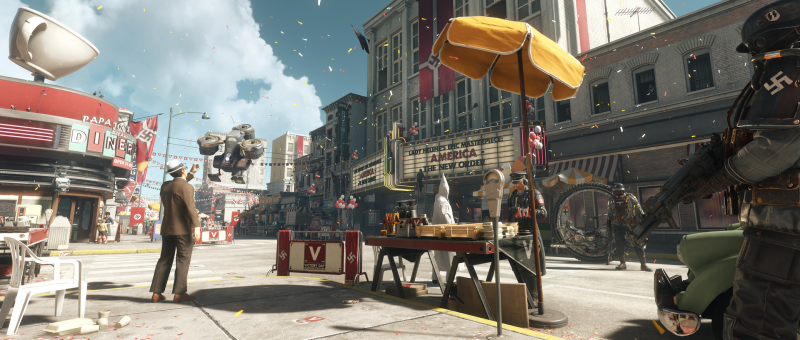
Both MachineGames and Starbreeze have a reputation for developing AAA games where character development is key. These games often have scenes that don’t advance the plot necessarily but give characters room to breath. This design philosophy seems pretty rare outside of BioWare games. Can you talk about why you think that is?
I think it’s two things. One of them is…I don’t think it’s actually true that it doesn’t move the plot forward. But, for example, the scene in The Darkness with Jenny on the couch does move the plot forward in that it makes what happens to Jenny later on more powerful. It wouldn’t be nearly as meaningful if that first scene didn’t exist, so they’re not there by accident.
And that’s the thing when you’re making a game. You have very little room for happy accidents, partly because the process is so expensive. Whatever you actually record and put into production has to matter, so things that don’t always look like they matter, we’ve layered in some sort of meaning that has a longer-term goal.
At the same time, I think we are very conscious of allowing the player to work at their own pace and there are many different players out there who want to achieve goals efficiently as they can and when they do that, they’re going to miss stuff – but that’s fine because that’s the kind of player they are and what they enjoy most. But for other players, they love to explore and getting something out of that. I think our goal is to create the richest, most emotionally believable world, a world that you can believe in and are transported to. A world like that has to respond to you no matter what you do, and so we invest a lot of time and effort in creating that experience.
We’re basically making a game we want to be inside of, and that’s what it all boils down to.
Both Doom and Wolfenstein are Bethesda properties now, and it feels like Doom went one way and embraced the heritage of the original game so hard – it’s very rhythmic and arcadey and over the top, and The New Order veered away from that, taking on a more narrative-focused design. Does MachineGames talk with id Software frequently? What do you think of the diverging paths of the two properties?
Yeah! We talk a lot with id. We love id and have a great relationship with them. I mean, we’re developing on the same engine, so we’re connected on a technical level, and I feel pretty happy we’re on different paths that help distinguish these games from one another, but I don’t necessarily agree that we changed the premise from the original Wolfenstein 3D. Back then what tools did they really have to tell a story? I think seeing the tools that they had at that time, I think they did. I think what we’re doing with Wolfenstein is a plausible interpretation of the original, considering the extreme difference in technical ability and just the experience we have compared to what a few teenagers back then had.
Because we really wanted to honor what the original Wolfenstein 3D was about. What we’ve done with BJ is as close as we could make him to the modern-day version of the original BJ Blazkowicz, which I think is different from a lot of other Wolfenstein games that came in-between, where he sort of veered between different looks and personalities.
For more on Wolfenstein II, check out our hands-on preview and 20 details we noticed from our time with the game.


